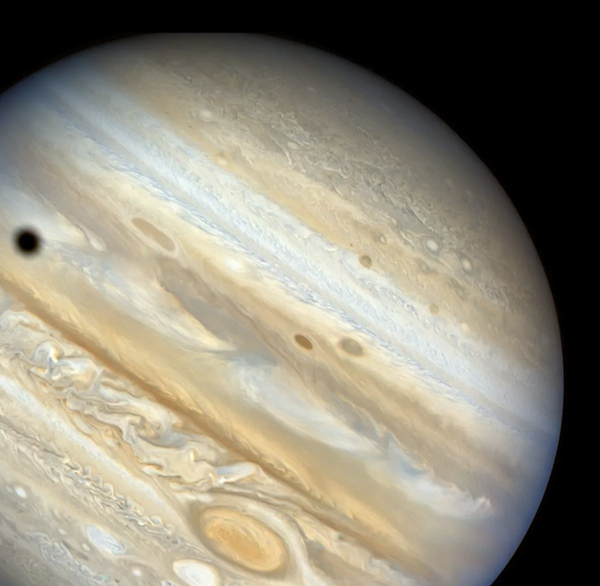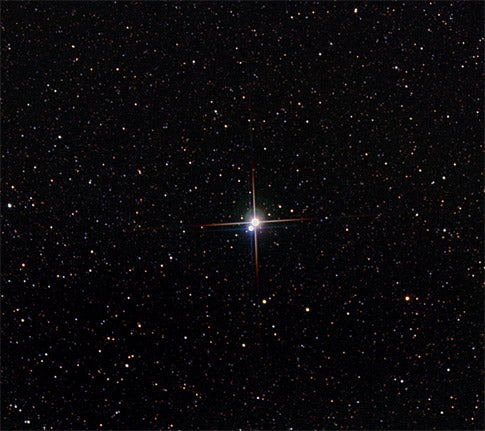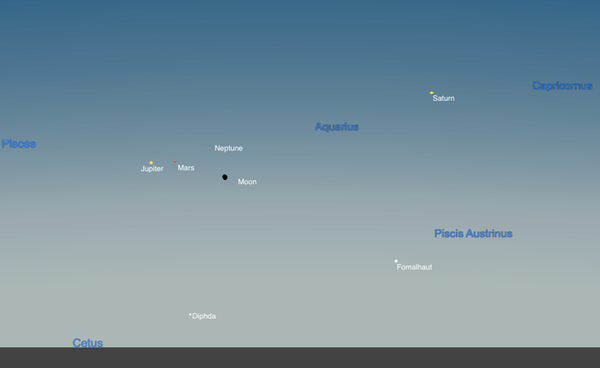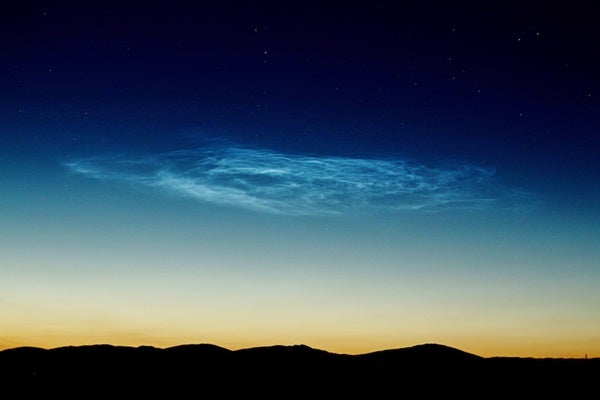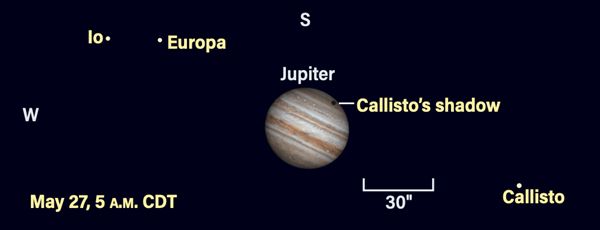Friday, May 20
A moonless sky this evening lets you take on one of spring’s greatest sights: the Virgo Cluster. Located (predictably) in Virgo the Maiden, this region contains numerous galaxies, including the famous elliptical galaxy M87, whose supermassive black hole was the first ever imaged.
To find this giant galaxy, start at magnitude 2.9 Vindemiatrix (Epsilon [ε] Virginis) and scan west, moving toward the star Denebola (Beta [β] Leonis) in Leo’s tail. M87 sits roughly halfway between these two stars. Alternatively, Astronomy columnist Glenn Chaple (who has plenty of great tips for viewing the Virgo Cluster) prefers to start his search for M87 at magnitude 4.9 Rho (ρ) Virginis and move northwest.
M87 is one of the brightest and most massive galaxies in the Virgo Cluster, weighing in at some 2 trillion to 3 trillion solar masses. From its distance of 55 million light-years, it glows at an apparent magnitude of 8.6 — easy to pick up with binoculars or any small scope. As an elliptical galaxy, M87 has no real structure, simply a brighter core surrounded by a fuzzy, elongated halo spanning 7′ or so.
Now, look just 1.5° west-northwest of M87. You’ll see two more galaxies sitting close together, separated by about 0.3°. That’s M84 (westernmost galaxy) and M86 (easternmost galaxy), both around 9th magnitude. These two galaxies are part of a larger group known as Markarian’s Chain but, as Chaple laments, the other members are too faint for small apertures under typical suburban skies.
Sunrise: 5:41 A.M.
Sunset: 8:13 P.M.
Moonrise: 12:38 A.M.
Moonset: 9:54 A.M.
Moon Phase: Waning gibbous (73%)
*Times for sunrise, sunset, moonrise, and moonset are given in local time from 40° N 90° W. The Moon’s illumination is given at 12 P.M. local time from the same location.
Saturday, May 21
Mercury reaches inferior conjunction at 3 P.M. EDT. The solar system’s smallest planet with reappear in the morning sky by next month.
Instead, let’s focus on a few other planets in the east early this morning. Two hours before sunrise, Jupiter, Mars, and Neptune all share the region of Pisces directly below (southeast of) the Circlet asterism. The Circlet consists of seven stars: Gamma (γ), 7, Theta (θ), Iota (ι), 19, Lambda (λ), and Kappa (κ) Piscium. This rough circle of stars sits about 12° south of a line drawn between Algenib and Markab, which marks one side of the Great Square of Pegasus. Gamma Psc is the brightest of the bunch — thought brightness is relative, as it shines at magnitude 3.7.
While your eyes are on the Circlet, however, take a look at 19 Psc, also cataloged as TX Psc. This is a variable star whose unmistakable deep red color comes from abundant carbon in its atmosphere. TX Psc ranges between magnitude 4.9 and 5.5 over the course of about 220 days.
Now drop your gaze toward the horizon from TX, and you’ll run smack dab into Jupiter, shining at magnitude –2.2. Nearly 5° its upper right (west) is Mars, a ruddy magnitude 0.7. Neptune, whose magnitude 7.8 glow will require binoculars to spot, sits an additional 2° west of Mars.
Magnitude 0.7 Saturn lies far to the west, lingering in Capricornus near the 1st-magnitude star Deneb Algedi. And within another hour, Venus will climb above the horizon, the brightest of our morning planets at magnitude –4.2.
Sunrise: 5:40 A.M.
Sunset: 8:14 P.M.
Moonrise: 1:25 A.M.
Moonset: 11:09 A.M.
Moon Phase: Waning gibbous (62%)
Sunday, May 22
The Moon passes 4° south of Saturn at 1 A.M. EDT. An hour before sunrise, while the sky is still dark, our satellite sits just over 5° directly below (southeast of) the ringed planet in the southeastern sky. Although the moonlight will largely wash out Saturn nearby, it’s still worth trying to catch a glimpse of the planet’s stunning ring system through a telescope.
Next, turn your gaze toward the Moon. The large, circular Mare Imbrium stands out in the lunar northwest, its southeastern rim marked by the rugged Apennine Mountains, named for the terrestrial mountain range in Italy. Just to the south is the bright crater Copernicus, which spans some 58 miles (93 kilometers). This lunar pockmark is extremely young, likely less than a billion years old, with several bright rays of ejecta — material thrown up and away by the impact — around it.
Last Quarter Moon occurs shortly after noon at 2:43 P.M. EDT.
Sunrise: 5:39 A.M.
Sunset: 8:15 P.M.
Moonrise: 2:01 A.M.
Moonset: 12:21 P.M.
Moon Phase: Waning gibbous (51%)
Monday, May 23
The Summer Triangle is now visible before local midnight, anchored by the three stars Deneb in Cygnus, Altair in Aquila, and Vega in Lyra. This famous warm-weather asterism is rising earlier each day and will soon soar overhead during the darkest hours of the night.
While Deneb is the brightest star in Cygnus, marking the Swan’s tail, his head, Albireo, is a stunning sight through a telescope — even a small one. The single star splits into two with gorgeous contrasting colors: a 3rd-magnitude primary shining with golden light and a 5th-magnitude blue-white secondary.
Of course, no two people see exactly the same colors, particularly when it comes to astronomical objects. So, look through your scope and decide for yourself what you see. Are the stars yellow and blue? Or gold and white? Might one of them even appear greenish? It can be fun to show off this star to family and friends, tallying up the most commonly seen colors.
Sunrise: 5:38 A.M.
Sunset: 8:16 P.M.
Moonrise: 2:31 A.M.
Moonset: 1:31 P.M.
Moon Phase: Waning crescent (40%)
Tuesday, May 24
It’s a busy day for Earth’s satellite as it tracks across the predawn sky. First, the Moon passes 4° south of Neptune at 6 A.M. EDT — after sunrise on the East Coast, but before the Sun is up in time zones farther west. At that time, our delicate crescent Moon sits in far eastern Aquarius, just 33 percent illuminated as nighttime moves across the lunar face. If you want to catch Neptune, try an hour or two earlier, when the sky is darker. Be aware, however, that the Moon’s light may wash out the ice giant’s feeble glow, requiring you to use larger apertures than you otherwise would to catch the distant planet.
Jupiter and Mars, barreling toward a conjunction on the 28th, are now just under 3° apart to the Moon’s upper right, both still visible in the growing twilight. The Moon is headed for a meetup with these two words as well, passing 3° south of Mars at 3 P.M. EDT, then 3° south of Jupiter at 8 P.M. EDT. By tomorrow morning, the Moon will sit southeast of the pair, and Mars and Jupiter will have inched about 0.5° closer. Keep watching these planets as they come closer each day, and make sure not to miss next week’s column for more details about the big event.
Sunrise: 5:38 A.M.
Sunset: 8:16 P.M.
Moonrise: 2:57 A.M.
Moonset: 2:38 P.M.
Moon Phase: Waning crescent (30%)
Wednesday, May 25
May kicks off noctilucent cloud (NLC) season, when these high-flying, night-glowing clouds appear for Northern Hemisphere observers.
Although clouds are typically abhorred by observers, they can provide a beautiful, ethereal target in their own right — the right clouds, at least. NLC are not your usual puffy, opaque clouds. These are high-altitude (typically 50 miles [80 km] high) clouds that occur when ice crystals form around dust particles in the upper atmosphere. They most often appear for observers between latitudes of 55° and 70° north and glow because although the Sun has sunk below the horizon from your point of view, our star continues to illuminate these delicate clouds as they sit high overhead. So, rather than “normal” clouds, which appear dark, NLC appear bright white or silver, even at night.
The best way to see NLC is to look north either late at night or early in the morning. NLC are unpredictable and ever changing, so you may want to check the sky multiple times over the course of a few hours. Fortunately, unlike many astronomical phenomena, NLC are easy to see with the naked eye, requiring no special equipment or planning. Plus, they’re stunning to photograph and can really add to your nightscape.
Check out more tips for observing NLC here.
Sunrise: 5:37 A.M.
Sunset: 8:17 P.M.
Moonrise: 3:21 A.M.
Moonset: 3:43 P.M.
Moon Phase: Waning crescent (21%)
Thursday, May 26
The Moon passes 0.2° south of Venus at 11 P.M. EDT. Of course, neither is visible at that time, so let’s catch the preshow in the early-morning sky. Half an hour before sunrise, the Moon — now a crescent that’s just 15 percent lit — sits nearly 8° west-southwest of Venus in the eastern sky. Venus, still blazingly bright at magnitude –4.0, should be easy to home in on with a telescope to view its 14″-wide disk. Like the Moon and Mercury, Venus goes through phases. It is now a 76-percent-lit waxing crescent. By the end of the month, it will be nearly 78 percent lit.
See how long you can follow the planet into the brightening dawn. Venus can be observed even after sunrise, but you must take extreme care. Only do so if you are experienced and have a tracking mount locked on Venus in the sky. Never try to find Venus (or any other target) with binoculars or a telescope when the Sun is up; even though you may think your aim is good, the chances are high of accidentally pointing your optics at the Sun and severely damaging your eyes. If you plan to observe the Sun, always do so only with the right equipment and solar filters in place.
Come back at the same time tomorrow morning to see that the Moon has slid southeast of Venus and waned several percent, our satellite now showing off 9-percent-lit crescent.
Sunrise: 5:37 A.M.
Sunset: 8:18 P.M.
Moonrise: 3:43 A.M.
Moonset: 4:45 P.M.
Moon Phase: Waning crescent (13%)
Friday, May 27
The Jupiter system puts on a show today, particularly for Midwestern and western observers. Callisto’s shadow spends 2.5 hours meandering across the gas giant’s face, starting at 5:31 A.M. EDT. (East Coast observers may just be able to catch the opening minutes of the transit before the Sun rises.)
As the event kicks off, Jupiter is already nearly 19° high in the Midwest. Callisto itself sits more than 1.5′ east of Jupiter, even as its shadow begins to blot out the cloud tops. All three other Galilean moons are visible as well; Ganymede sits farther east, while Europa (closest to the planet) and Io sit to Jupiter’s west.
An hour later, the shadow has made it nearly halfway across the disk, skimming along the far southern regions of the planet. And 12 hours from now, when Jupiter is unfortunately unobservable, Callisto itself will just skim across the planet’s south pole in a transit lasting a mere 30 minutes.
Sunrise: 5:36 A.M.
Sunset: 8:19 P.M.
Moonrise: 4:06 A.M.
Moonset: 5:49 P.M.
Moon Phase: Waning crescent (7%)

